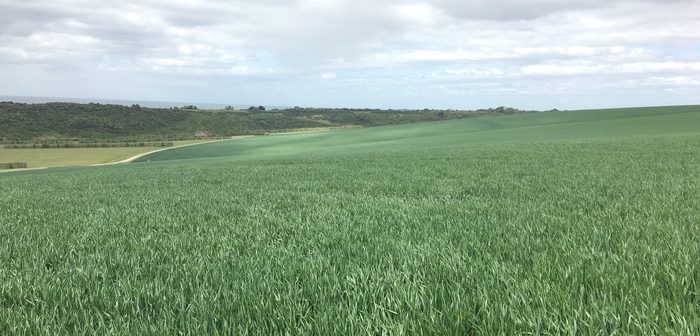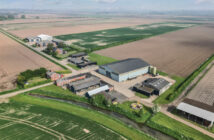Functional traits can already add cost benefits equivalent to 20% of extra yield and a return on investment of 300% on seed cost, but as John Swire discovered in the June edition of Agronomist and Arable Farmer the future will deliver much more
Functional traits such as disease resistance, standing power and harvest date can simplify management and reduce production costs to a much greater degree than many currently believe, a new report from seed breeders KWS suggests.
Secondary factors such as savings in diesel, labour, machinery replacement and better soil condition can multiply the benefits many times over and help producers meet the requirements of integrated pest management (IPM) demands and environmental legislation much easier.
With the challenges of a reduced agrochemical arsenal, increasingly variable growing conditions and the need to reduce the carbon footprint of agriculture in the future, development of enhanced genetic properties will become increasingly important, says KWS product development manager John Miles.
“It’s a simple truth that 80% of the potential crop production you are likely to see is in-built in the seed you drill.
“You can influence it to a degree by good management, how much N you apply and the standard of your agronomy, but fundamentally what you will get from a yield and quality perspective is locked in when you make that variety decision.
“What is key is making sure that you choose the right variety with regard to your own individual growing circumstances as this will have a profound effect on the management you will have to use and the whole cost-benefit equation.
“It’s too easy to look at something like standing power and think it might save you a bit on growth regulators, but when you look at the whole picture the cost benefit implications are much more significant.
“There are the initial saving on PGRs, but that’s but the start. Once you factor in savings in diesel, labour, machinery hours and add it to earlier and easier harvesting, simpler cultivations and potentially less soil damage, the benefits are huge.
“In terms of KWS’s Group 2 winter wheat Extase, if you combine fungicide reduction due to a lower risk situation at £60/ha with retention of premium at £171/ha using the RL’s 11.4t/ha yield for the variety, the value of these adds up to £231/ha.
“With our Group 3 variety Firefly, we estimate the greater security in the field, reduced PGR and drying costs combined with premium retention is worth about £140/ha.
“It involves a change of mindset but focusing on what a variety brings to your management in terms of functional traits alone could produce cost benefits equivalent to 20% extra yield – it is that significant.
“This is borne out by the £231/ha additional benefits from Extase before factoring in the cost advantages of earlier ripening and earlier harvesting and its effect on timeliness throughout the critical autumn period.
“At approximately, £75 – £80/ha for seed on-farm, this suggests around a 300% return on investment is possible from functional traits alone before higher yields are accounted for.
“Whilst developing new varieties and producing seed is always costly and time consuming for breeders, these gains represent sizeable opportunities for growers. These gains are likely to be even more in the future.”
Looking to the future
KWS knowledge transfer manager Dr. Kirsty Richards says such thinking will underpin all its future breeding with its new SPP (Sowing for Peak Performance) initiative putting the emphasis more on functionality and resilience of varieties rather than just outright potential yield in the future.
“Getting the most production from the resources you have available to you is the key to being sustainable and in
general terms this means achieving as much yield as you can from your land.
“But at an individual level it means your soil type, growing conditions and location to markets are key elements
in your seed decisions so you can select the best varieties possible for your own unique circumstances.
“KWS Dynamic Wheats already mean you can maximise the market value of your production through optimising the balance between yield and quality to best target opportunities with the highest return.
“In the future it’s likely varieties will be available specifically matched to the cultivation system you use, with greater ability to use the Nitrogen you apply and that require simpler management requiring less man hours.”
Climate change impact
Climate change has become a reality for many growers over the last few years with growing conditions not just varying dramatically between the years but also within the same season itself, she points out.
“The end result of this is that traditional timings for field operations become less important and farming by crop growth stage often becomes the main management aim.
“This means that when a window of opportunity arises, you could have several functions to address at once. In addition, windows that have traditionally been several weeks can now be reduced to just a few days.
“Focusing on breeding varieties with high resilience in the face of adverse growing conditions and the ability to express optimum full genetic potential in a variety of less than optimal circumstances is therefore a key priority.
“But it’s also about developing varieties that are more ‘self contained’ so they are less dependent on time critical interventions such as specific fungicide applications.”
More variable growing conditions put more abiotic stress on growing plants as well as often producing the type of weather conditions and micro-climates that encourage the development of yield-sapping diseases, he adds.
“At a time when we are rapidly losing our arsenal of chemistry to control these diseases, this is a far from ideal situation.
“Breeding varieties with high levels of resistance to the most damaging diseases has been a key KWS aim for many years and our current portfolio is strong proof of this with some of the highest scores for resistance to Septoria, Mildew and Rusts on the RL.
“Varieties that need less agronomic interventions, cost less to produce and deliver higher returns, too, so a key aim of ours is to ensure genetics and chemistry work in partnership to the best effect in the future.”
SPP delivers multiple benefits
But the challenge won’t be just about taking the pressure of fungicides, she says.
“Stronger growing varieties with fast speed of development and good ground cover have potential to outcompete weeds more easily plus stiffer straw means you’re unlikely to be as reliant on PGRs and achieve easier, quicker harvesting.
“We’re also focusing on N–efficiency. Varieties that are more efficient at utilising valuable Nitrogen result in more of this being used for growth than being lost from the system. Such varieties will not only deliver obvious benefits to the environment they will also transform production economics, too.
“The less time you spend applying agrochemicals and fertilisers, the more you are saving on labour, diesel and machinery wear and tear and, ultimately, replacement.”
The less time and money you spend managing your crops the less time you will hopefully spend in the tractor cab, he adds
“KWS’s genetic properties can help do much to replace the ‘heavy lifting’ achieved by conventional crop production inputs and activities currently, so the less you should be travelling on your land.
“Less travel means less potential damage to soils and less time and money spent trying to correct the compaction problems associated with multiple wheelings and carrying out operations is unsuitable conditions.
“For example, earlier harvesting means you have more chance of avoiding the worst of the autumn weather and gives you more time to prepare land properly and in a manner that reduces soil damage to a minimum.
“It also gives you a greater choice of crop options whilst varieties with greater flexibility over drilling date avoid the problem of potentially undrilled fields that could be exposed to soil erosion over the winter.”






